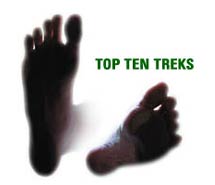|
Outline Itinerary
Flights from Heathrow generally fly out at around 21:00. So if you are flying from Heathrow, you will not arrive at the hostel before midnight, but it will be open.
Please note that variations to these itineraries may occur due to roads being impassable, acts of God (who is still very active in Iceland!) and sometimes through substitution of chartered
for scheduled transport. Other circumstances may cause minor changes.
Day 1: Fly to Keflavik, transfer to your accommodation in Reykjavik.
Day 2: Assemble and take bus to Skogar where there is an impressive waterfall and an outstanding local museum. Start trek up to near the summit of Fhimmvorduhals (@ 940m), passing between the glorious Eyjafallajokull and Myrdalsjokull ice caps. Reach Hut near to Fimmvorouhals. Look out for the horny Icelandic sheep! (Circa 12km)
Day 3: Setting out from the hut we cross over a high pass and commence a spectacular descent to the wooded area of Thorsmork. (c. 12km)
Day 4: Spent in Thorsmork, relaxing, wildlife viewing, and local walks.
Day 5: A long walk today; heading north through Emstrua to the Markarfljot Bridge, cross the river and follow the spectacular gorge south to the Einhyrningur Hut set in a grassyarea . (c. 21km)
Day 6: Descend from the hut to the glacial River Gilsa, which we have to cross in order to find the trail heading along beside the river and then across the rich lawns to the turf roofed Fljotsdalur Hostel amidst its panoramic setting with sweeping vistas towards the sea and mountains. Here you will find a little library with books concerning aspects of Iceland. There are also good bird watching opportunities. (15km)
Day 7: Free day in Fljotsdalur: local walks etc.
Day 8: Departure to Reykjavik (135km) to arrive about midday. There may be the opportunity for some or all the group to divert and return via Gullfoss and Geysir (this will be at an extra cost) return at about 17:00 to hostel.
Day 9: Heathrow passengers flight departs at around16.00, so they will have some time to look around Reykjavik, one of Europe's smallest Capital cities. A colourful low rise town, with some interesting new-ish buildings such as the huge icicle-like concrete church and the dock area, which contains some interesting if not exactly cheap restaurants.
Transfer to Keflavik airport.
Books & Maps
It is suggested that no books are brought on the trek. Weight is at a premium whilst backpacking. As background reading before departure the following is a useful source of information on Iceland in general.
Thorsmork/Landmannalaugar 1:100,000 map £7.00
N.B It is possible to leave pre-packed clean clothes, etc., with the organisers at the beginning of the trip, to be picked up at the end. This is usually more suitable than leaving packages at the Reykjavik accommodation.
Included
Return flight by 'Icelandair' from Heathrow to Keflavik, transfer to and from Reykjavik. All food on trek, but breakfasts only in Reykjavik. The Icelandic government on passengers leaving Keflavik by air levies an "international departure tax"; it is included in quoted tour charges. No visa is required for citizens of the EC, USA, Canada or Australia. |



